IJN main cruiser reconnaissance floatplane in 1941
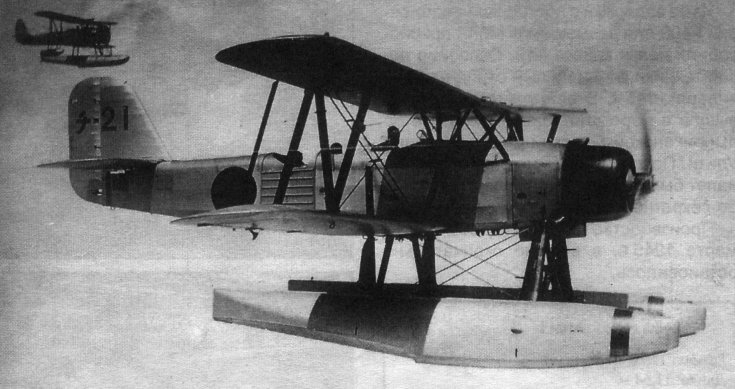
In 1932, the Imperial Japanese Navy requested Kawanishi Aircraft to replace its previous E5K (1931) as part of the 7-Shi requirement. The new design was designated E7K1, powered by a 462 kW (620 hp) Hiro Type 91 W-12 inline engine to reach better speed. The first flew on 6 February 1933 already, trialled by the Navy in May, competiting with the Aichi AB-6. The E7K1 was accepted based on better performances overall, and ordered as the Navy Type 94 Reconnaissance Seaplane (九四式水上偵察機), entering service by early 1935. A popular aircraft despite the unrelliable liquid-cooled Hiro engine, the production swapped on an improved Hiro 91, which was still unreliabe. At last in 1938 Kawanishi introduced the E7K2 with a Mitsubishi Zuisei 11 radial, far more reliable and powerful. This brand new variant first flew in August 1938, ordered soon as the "Navy Type 94 Reconnaissance Seaplane Model 2", the E7K1 being renamed Model 1 retrospectively.
The E7K was deployed from 1936 (Model 1) over China, and until the Pearl Harbor. The E7K1 was versed in second-line duties, notably training, while the E7K2 fought on first line until 1943, some even ending as kamikaze in 1945. It was often compared to the Nakajima E8N, but the latter was a smaller type, main battleship model for artillery spotting. In countless engagements, the main reconnaissance model was the Kawanishi E7K2 catapulted by IJN cruisers. It even motivatied the conversion of entire cruisers like the Mogami as hybrid seaplane carriers, or construction of the Tone class.
Design Development of the E7K
The failure of the Navy E5Y Project
In early 1932, it became apparent to the Imperial Japanese Navy Staff that replacing the ageing 14 E1Y2 long-range shipborne reconnaissance aircraft was now urgent. There was already a specification emitted and answers, but none was considered worthy of a production, despite combined efforts of Aichi, Kawanishi and Nakajima under Yokosuka state arsenal supervision. Thus work had been going on from 1928 to 1931 with little to show for it.The Navy Type 90-3 E5Y1 indeed failed to meet requirements and was barely superior to its predecessor. In the end, the admiralty choose instead to stick to a modified version of the Type 14 long-range reconnaissance aircraft, known as Aichi E1Y3. This was temporary however, and the technical department of the Kaigun Koku Hombu Fleet Air Headquarters started a new design competition open to all manufacturers. This ended the policy of state-design models. From now on until 1945, competition ("Shisaku Seizo" or "shi") between manufacturers became the norm rather than cooperation.
From now on all these open competition would had "Shi-" added to a numerical prefix with the development year from the Showa era (1926) and the first of these was 6-Shi in 1931. The same year it was to address the need for a night flying boat, a carrier-based dive bomber and two-seat carrier-based bomber. They led to nowhere, but in 1932 7-Shi became the most ambitious and largest od such programs, with a carrier-based fighter, torpedo bomber, dive bomber, carrier-based heavy strike aircraft, ground bomber, long-range shipborne reconnaissance aircraft, the project which concerns us.
The latter was proposed to Kawanishi and Aichi, which had good knowhow with long-range reconnaissance aircraft and were familiar with E5Y/E5K project issues. Aichi developed the eye-pleasing AB-6 with an enclosed cockpit, wing fairings and slats but all these innovations prevented to play on the essentials and this one lost as a competitor to Kawanishi. The latter surprise all since the company since then had not produced a single successful military project, having exerted its meagre talents until then on the civil market. It had to acquire licence of floats and floatplaned for others to gain experience.
About Kawanishi
Kawanishi was founded by Seibei in 1918, alongside Chukuhei Nakajima, which cooperated for a year before departing their own way in 1919. "Kawanishi Kikai Seisakusho" starting the production of machine tools for the textile industry at first. Apparently Chukuhei Nakajima's behaviour angered many of his talented engineers which left Nakajima and followed Senbei Kawanishi, and this included the director Eiji Sekiguchi, engineers Fujio Togawa, Konoshin Tamaki, and test pilot Yukichi Goto. Thanks to this, an aviation department was created and work started of the first models.From 1922 the commpany was managed by Ryuzo Kawanishi and completely switched to aviation. Eiji Sekiguchi succeeded in having several projects of transport aircraft built for the civilian market, and the company tried, but failed to be retained in a carrier-based fighter program. The K-11 was unsuccessful but the company purchased E2N1, E4N2, E5K1 and other floatplane models for tests. When it came, the Company, which gained considerable experience of the years, felt ready to address the new 7-Shi long-range reconnaissance floatplane.
Detailed Design
The design of "Type J" (factory designation) was fairly conservative in comparison of the Aichi model. The forward section was cladded in duralumin, the rest was covered with linen with separate duralumin inserts on the hood and cockpit. It was designed to be powered by the Type 91 W-12 cyclinders, in-line engine which was part of the 7-Shi specs, a licenced verison of the French W12 Lorraine-Dietrich, made by Hiro as the 12Eb in the 11th fleet arsenal. This new engine developed 500 hp and up to 620 at takeoff speed. It was coupled with a two-bladed wooden constant-pitch propeller.The nose was moved quite far forward due to the lenght of the engine, as behind were located a large fuel and oil tanks, as range was a priority. The propeller was so well forward that the propeller arc reached the tip of the floats. There were open separate cockpits for the pilot, navigator and gunner-observern the latter installed back to back in a small space. This eased somewhat communication. Both the pilot and navigator had plexiglas visors while the navigator had a duplicated aircraft dashboard, with simplified instrumentation, but no double command. The gunner's seat was recessed eneough so that in stowed position he did not protrude up. He moved on a folding seat and higher position to fire with the flexible-mounted machine gun. A second machine gun was located on a retractable bracket in the lower hatch installation, to protect the floatplane's belly. To be fired, the gunner folded the seat and lied down at the bottom of the fuselage.
The main structure called for a single-keel scheme without additional braces and struts. It was reinforced enough to withstand the stress of taking off from a catapult, and manipulations when recovering it at sea. As a biplane or equal span wings, both 14 meters in all, procured stability and lift. Wing consoles were connected by N-shaped struts. The upper wing was slightly forward compared to the lower one, and attached to the fuselage with N-shaped struts. The lower wing received extra reinforcement structs connected to the fuselage and the biplane could fold back on hinges along the fuselage, easing storage. Its landing gear comprised two floats attached at four points on large legs, reinforced by X type bracing. This was sturdy and reliable combination, if not not innovative. But if the structure was sound, it will soon appear that the choice of engine, based on paper performances, was less than ideal.
First flight of the protoype
The prototype "Type J" flew on February 6, 1933. Tests went on at Kawanishi until May 1933, after which it was handed over to the fleet's commission for comparative testing with its rival Aichi AB-6. The provisional armament were two Type 92 machine guns, lower and upper position aft and a single Vickers synchronized MG on the hood. A standard bomb rack was installed underbelly, able to carry up to four 30-kg or two 60-kg bombs. This was not bad for a reconnaissance model, enabling extra capabilities. Comparative tests took place at the Yokosuka Kokutai base, and lasted for a year. Both performed equally, although Kavanishi's mode proved a little faster and easier to pilot. The Aichi model shone in takeoff and landing characteristics only. The Navy preferred the Kawanishi prototype and asked to improve the model on some points for new tests.Second protoype (1934)
By April 1934, Kawanishi presented a second prototype, designated already "Long-range reconnaissance hydroplane Type 94 model 1", simplified as E7K1. By May, after new tests, the technical department of the Kaigun Koku Hombu fleet concluded the Kawanishi reconnaissance aircraft was a definitive choice, accepted for production.Production of the E7K1
It wa the first model of the new Kawanishi plant created near the village of Naruo, halfway between Osaka and Kobe. The first serial model had the very same engine as the prototype, soon replaced by an improved version Hiro Type 91 model 2 rated for 750 hp on takeoff, 600 hp normal use. It was connected to a four-bladed fixed-pitch wooden propeller. The Vickers foward machine gun was removed, but it seems a telescopic sight was kept. Production was set up for a first run at the end of 1934. In 1935, the Sugita "Nippon Hikoki K.K." plant was chosen to join serial production. In total until 1937, 183 E7K1 were assembled (57 for Nippon Hikoki K.K.).By the fall of 1937, the model was stopped due to obsolescence. However next specifications would fail to procure a suitable replacement, delayed, and it was decided to resume production of Type 94 biplane based solely on reliability, although with engine issues.
Development of the E7K2
By early 1938, an improved version was developed called 'Type 94 model 2', later known as E7K2. The airframe and fuselage were kept unchanged but it was chosen to replace its relatively temperamental older and less powerful engine by a brand new air-cooled Mitsubishi 14-cylinder MK2A Zuisei 11, 28 liters in capacitt. It was probably the most successful Japanese aircraft engine of the time, adopted by the Navy and army as Ha-26. Output on takeoff rose to 875 hp. The modified version prototype first flow in August 1938 and was immediately authorized for production. Flight performance was still in the same vein, albeit a better speed, and moreover much greater reliability and service life. In fact this new version was so successful, greater orders were placed and it constituted overall the bulk of the E7K production.Production went on until November 1939 with a scheduled replacement at last by the monoplane E13A1 in the same rile when finally adopted. Both Kawanishi and Nippon Hikoki, K.K. delivered respectively 288 and 60 E7K2, for a total of 348, compared to 183 for the E7K1, and a total overall of 531 units, whereas other sources states 533 (indeed with the two prototypes). By the fall of 1939, the model was nevertheless outdated and only stayed frontline due to the lack of replacement, as the new E13A needed time for production to be stepped up. The E7K1 with the Hiro Type 91 engine was meanwhile sidelined to training.
Despite its age, the E7K was nevertheless popular with its crews and pilots for an excellent handling, good visibility overall, and for the Navy, their great autonomy, which was paramount to create a wide reconnaissance area around the fleet. Each cruiser carried indeed from two to four of them, sometimes even more, like the Tone class. A classic squadron of cruiser (four) was indeed capable of sending a total of eight in the air at all times, probing all directions.
Variants:
E7K1: Production version with a Hiro Type 91 520 hp water-cooled W-12 engine, 183 built (including 57 built by Nippon Hikoki K.K.)E7K2: Re-engined version with a Mitsubishi Zuisei 11 radial engine, about 350 built (including 60 built by Nippon Hikoki K.K.)
E7K2 1938 | |
| Crew: | 3: Pilot, Observer, Rear gunner |
| Fuselage Lenght | 10.41 m (34 ft 2 in) |
| Wingspan | 14 m (45 ft 11 in) |
| Wing area | 43.6 m2 (469 sq ft) |
| Height | 4.85 m (15 ft 11 in) |
| Empty weight: | 2,100 kg (4,630 lb) |
| Gross weight: | 3,300 kg (7,275 lb) |
| Propeller: | 2-bladed metal propeller |
| Engine: | Mitsubishi MK2 Zuisei 11, 14-cyl AC radial 650 kW (870 hp) TO |
| Top speed: | 276 km/h (171 mph, 149 kn) at 2,000 m (6,562 ft) |
| Cruise speed: | 185 km/h (115 mph, 100 kn) at 1,000 m (3,281 ft) |
| Climb rate: | 3,000 m (9,843 ft) in 9 minutes 6 seconds |
| Climb rate: | 3,000 m (9,843 ft) in 9 minutes 6 seconds |
| Endurance: | |
| Service ceiling: | 9,800 m (32,200 ft) |
| Wing Loading: | 75.7 kg/m2 (15.5 lb/sq ft) |
| Power/mass: | 0.196 kW/kg (0.119 hp/lb) |
| Armament: MGs | 3: fixed Type 97 Vickers fwd, 2× trainable 7.7 mm Type 92 Lewis gun ventral/dorsal |
| Bombs and other Payloads | 120 kg (264.6 lb) of bombs |
Active service

E7K in flight, with a E8N in the background
By the end of 1935, the E7K1 had completely replaced the previous model in the fleet, paired with Nakajima E8N. Battleships were sometimes provided the E7K in complement. Two however were on board all heavy cruisers, and one per light cruiser. They were not distributed to tenders or seaplane carriers although a few E7K were distributed to the Kamikawa Maru, Kimikawa Maru, Kiyokawa Maru, Kunikawa Maru, Kagu Maru, and Kinugasa Maru as organic reconnaissance model. However the Navy staff preferred smaller models, and the E8N was still chosen over the E7K. Coastal air bases also were provided a few E7Ks. The baptisme of fire started with the 2nd Sino-Japanese incident by August 1937. Seaplane tenders took part in cooastal operations but mainly deployed the Nakajima E8N.
By August 14, 1937, the Japanese air forces launched long range raids and deep penetration, but the Chinese Air Force retaliated with around 40 Northrop "Gamma" escorting by Curtiss "Hawk" III fighters. They directly headed for the headquarters of the Japanese 3rd Fleet, in Shanghai. There was no defence left in the area and and later local E7K reconnaissance from the flagship of the 3rd fleet and from the old Izumo plus a single E8N from IJN Sendai were launched and tried to counter these. The armored cruiser Izumo lost its E7K even before gaining altitude, but this allowed a diversion and the E8N from Sendai shot down one Hawk III. The E7K1 was also used for bombing missions, but with limited success.
On September 19, 1937 (offensive on Nanking), Eight E7K from the Maizuru kokutai took off with bombs to attack a Chinese convoy on the outskirts, intercepted by a single Boeing P-26 "Peashooter" from the 17th Squadron, 3rd Group (Captain Wong Sun Shui), but could shot down none, repelled by concentrated fire from the Japanese gunners. The convoy was bombed and two armored vehicles, 9 trucks were reported destroyed. Those from Chinkai Kokutai (Korea) patrolled the blockade of the Chinese coast and Yellow Sea, and attacked targets of oppurtunity.
By December 1942, the E7K2 started to be withdrawn but they were still used by coastal units and the “Alf” served in the Hataka kokutai in Kure, totalling 54 E7K2s and 48 short-range E8N2s. In Korea, Chinkai Kokutai operated six, as in in Yokosuka Kokutai. Eight E7K2 served also in Komatsujima kokutai (Aichi Prefecture), six with Maizuru kokutai, six with the 18th Kokutai (Saipan), 10 with the 19th Kokutai (Kwajalain) at the time of Pearl Harbor and afterwards.
E7K2 served until early 1943 both declining due to numbers shot down, replaced, or simply worn out. Surviving E7K2 ended in turn with training units, replacing the K1. Experiments were done, like towing the Kugisho MXY3 target glider or radio control the MXY4. In the latter case, it was launched from a special ramp on the upper wing. By June 1943 in Niihama near Kure was created the "Takuma Kokutai" to train floatplane crews with the E7K2. It operated until September 1944 but was reorganized and fusioned with Yokohama kokutai with a mix of H8K "Emily", Aichi E13A "Jake" to form a combat unit, and the largest hydroaviation base in Japan. Their task was combat patrols around the Home Islands.
By February 1945, the same unit was modified to form Special Attack units at Takuma base. They were turned into kamikaze to attack US Forces at Okinawa. The Squadron "Kotohira Suishin" comprised E7K2s modified to be equipped with a new rack capable of holding a 250-kg bomb. By April 1945, four suicide attacks saw the entire Takuma Kokutai wiped out even before reching its objective. They were spotted by radar and intercepted by hordes of F6F and F4U, all easy meat before even approaching their fleet. The remainder were sold for scrap and none survived in any museum.
Read More
On alchetron.comon airwar.ru
On ww2aircraft.net/
On valka.cz
on combinedfleet.com
On aviastar.org
On ipms-sg.ch
on pacificeagles.net/
On wikipedia.org
Model kits
modelplanes.dewpalette.com
britmodeller.com
Gallery
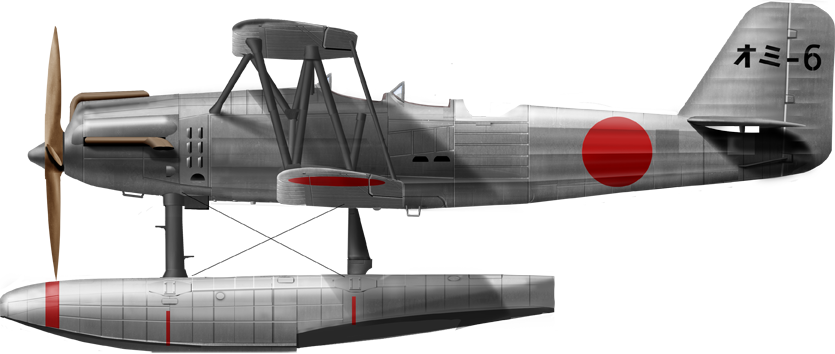
Basic early production Type 94 Type 1, 1935
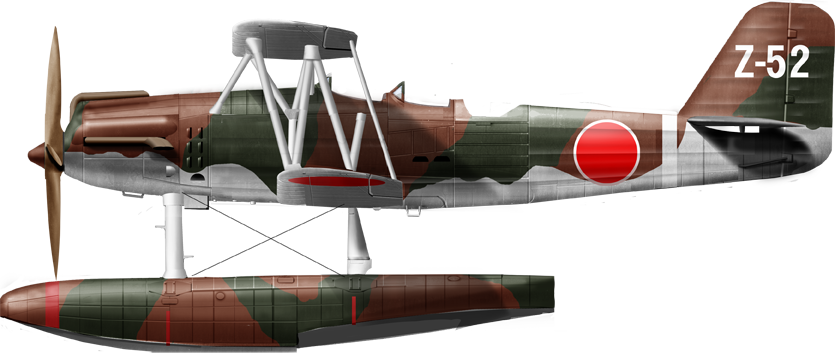
E7K1 Navy Air Base Chiyoda, Tokyo, 1939

E7K1, Seaplane Carrier Kamoi, 1937
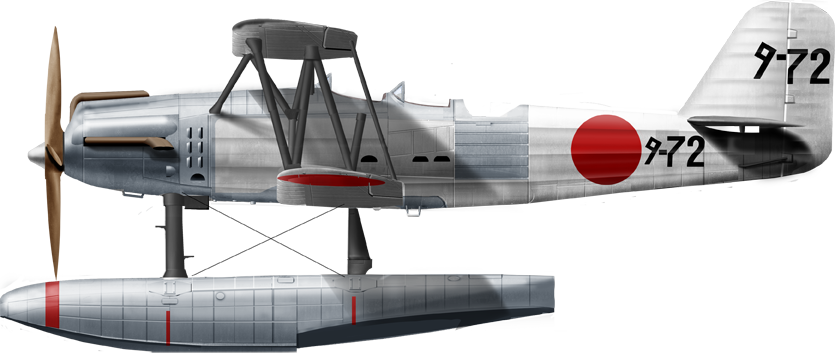
E7K1 Tateyama Kokutai, 1940
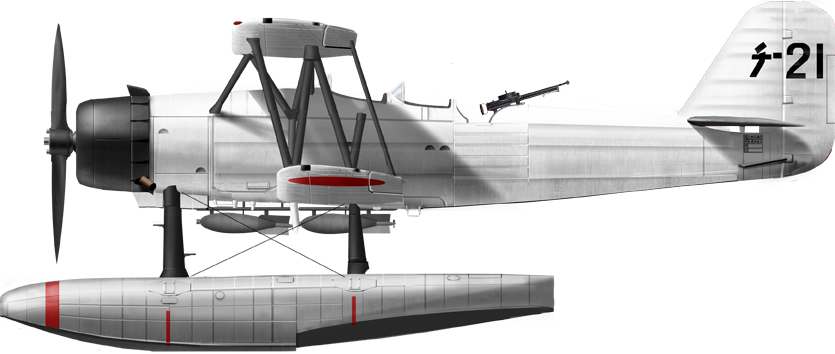
E7K2 in 1939

E7K2 on IJN Abukuma, 1941
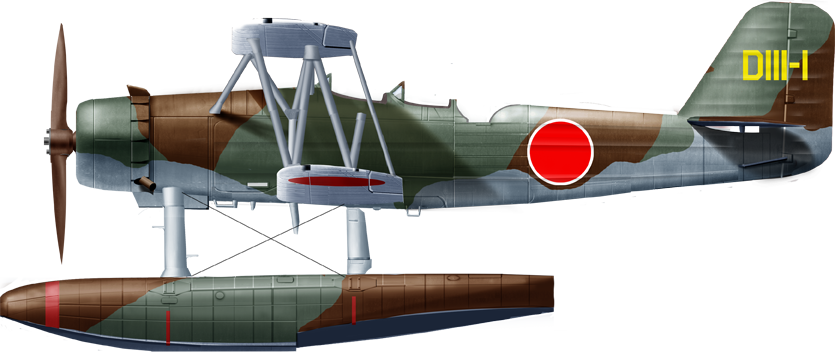
E7K2 model 2 on IJN Sendai, 19 December 1941, invasion of Malaya. That day she detected and reported the Dutch submarine O-20, later sunk by destroyers.
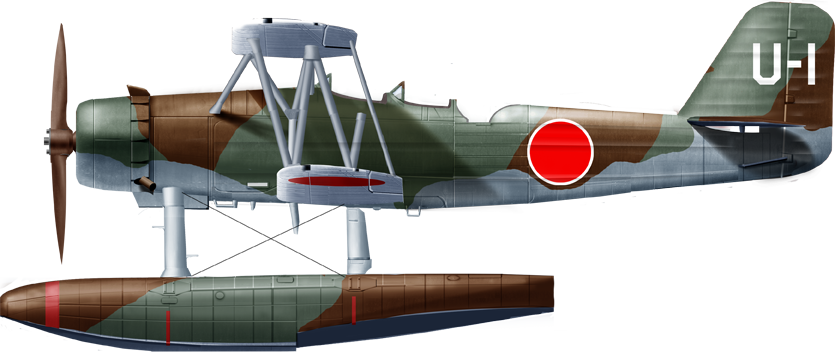
E7K2 on IJN Kashii, Burma, 1942
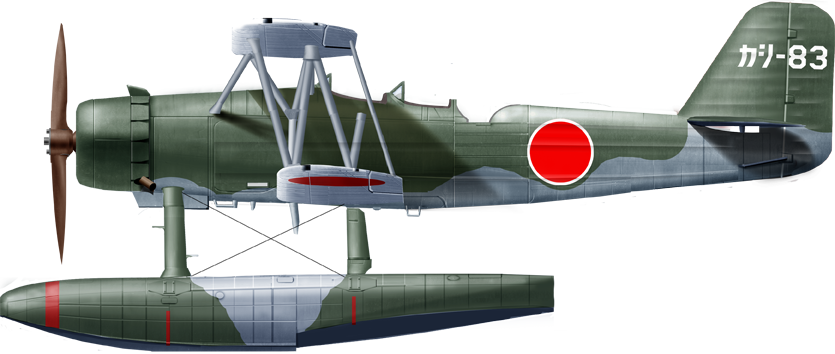
E7K2 from Kashuwa Kokutai, Chiba Preferecture, Japan, 1943
Photos

In a Russian publication src
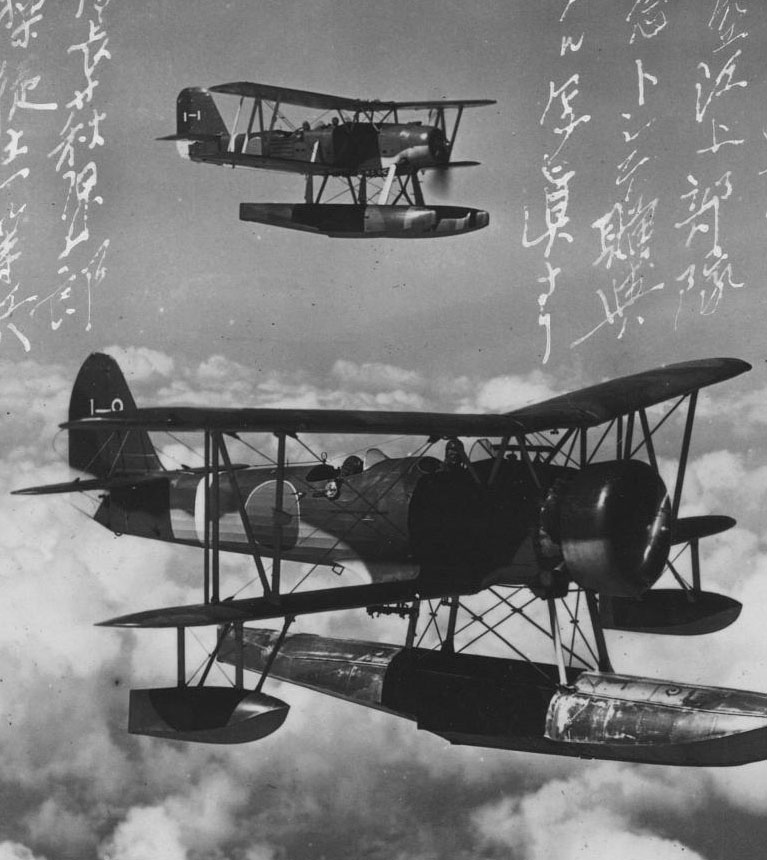
E7K and E8N in flight together, the main spotter-reconnaissance models of the IJN in 1940

The same, different angle, colorized by Irootoko jr.

E7K in flight. All: CC
- Lohner E (1913)
- Macchi M3 (1916)
- Macchi M5 (1918)
- Ansaldo ISVA (1918)
- Sopwith Baby (1916)
- Short 184 (1916)
- Fairey Campania (1917)
- Sopwith Cuckoo (1917)
- Felixstowe F.2 (1917)
- Friedrichshafen FF 33 (1916)
- Albatros W4 (1916)
- Albatros W8 (1918)
- Hanriot HD.2
- Grigorovitch M5
- IJN Farman MF.7
- IJN Yokosho Type Mo
- Yokosho Rogou Kougata (1917)
- Yokosuka Igo-Ko (1920)
- Curtiss N9 (1916)
- Aeromarine 39
- Vought VE-7
- Douglas DT (1921)
- Boeing FB.5 (1923)
- Boeing F4B (1928)
- Vought O2U/O3U Corsair (1928)
- Blackburn Blackburn (1922)
- Supermarine Seagull (1922)
- Blackburn Ripon (1926)
- Fairey IIIF (1927)
- Fairey Seal (1930)
- LGL-32 C.1 (1927)
- Caspar U1 (1921)
- Dornier Do J Wal (1922)
- Rohrbach R-III (1924)
- Mitsubishi 1MF (1923)
- Mitsubishi B1M (1923)
- Yokosuka E1Y (1923)
- Nakajima A1N (1927)
- Nakajima E2N (1927)
- Mitsubishi B2M (1927)
- Nakajima A4N (1929)
- CANT 18
WW1
✠ K.u.K. Seefliegerkorps:
 Italian Naval Aviation
Italian Naval Aviation
 RNAS
RNAS
 Marineflieger
Marineflieger
 French Naval Aviation
French Naval Aviation
 Russian Naval Aviation
Russian Naval Aviation
 IJN Air Service
IJN Air Service
 USA
USA
Interwar
 Interwar US
Interwar US
 Interwar Britain
Interwar Britain
 Interwar France
Interwar France
 Interwar Germany
Interwar Germany
 Interwar Japan
Interwar Japan
 Interwar Italy
Interwar Italy
- Curtiss SOC seagull (1934)
- Grumman FF (1931)
- Curtiss F11C Goshawk (1932)
- Grumman F2F (1933)
- Grumman F3F (1935)
- Northrop BT-1 (1935)
- Grumman J2F Duck (1936)
- Consolidated PBY Catalina (1935)
- Brewster/NAF SBN-1 (1936)
- Curtiss SBC Helldiver (1936)
- Vought SB2U Vindicator (1936)
- Brewster F2A Buffalo (1937)
- Douglas TBD Devastator (1937)
- Vought Kingfisher (1938)
- Curtiss SO3C Seamew (1939)
- Douglas SBD Dauntless (1939)
- Grumman F4F Wildcat (1940)
- F4U Corsair (NE) (1940)
- Brewster SB2A Buccaneer (1941)
- Grumman TBF/TBM Avenger (1941)
- Consolidated TBY Sea Wolf (1941)
- Grumman F6F Hellcat (1942)
- Curtiss SB2C Helldiver (1942)
- Curtiss SC Seahawk (1944)
- Grumman F8F Bearcat (1944)
- Ryan FR-1 Fireball (1944)
- Douglas AD-1 Skyraider (1945)
Fleet Air Arm
- Fairey Swordfish (1934)
- Blackburn Shark (1934)
- Supermarine Walrus (1936)
- Fairey Seafox (1936)
- Blackburn Skua (1937)
- Short Sunderland (1937)
- Blackburn Roc (1938)
- Fairey Albacore (1940)
- Fairey Fulmar (1940)
- Grumman Martlet (1941)
- Hawker sea Hurricane (1941)
- Brewster Bermuda (1942)
- Fairey Barracuda (1943)
- Fairey Firefly (1943)
- Grumman Tarpon (1943)
- Grumman Gannet (1943)
- Supermarine seafire (1943)
- Blackburn Firebrand (1944)
- Hawker Sea Fury (1944)
IJN aviation
- Aichi D1A "Susie" (1934)
- Mitsubishi A5M "Claude" (1935)
- Nakajima A4N (1935)
- Yokosuka B4Y "Jean" (1935)
- Mitsubishi G3M "Nell" (1935)
- Nakajima E8N "Dave" (1935)
- Kawanishi E7K "Alf" (1935)
- Nakajima B5N "Kate" (1937)
- Kawanishi H6K "Mavis" (1938)
- Aichi D3A "Val" (1940)
- Mitsubishi A6M "zeke" (1940)
- Nakajima E14Y "Glen" (1941)
- Nakajima B6N "Jill" (1941)
- Mitsubishi F1M "pete" (1941)
- Aichi E13A Reisu "Jake" (1941)
- Kawanishi E15K Shiun "Norm" (1941)
- Nakajima C6N Saiun "Myrt" (1942)
- Yokosuka D4Y "Judy" (1942)
- Kyushu Q1W Tokai "Lorna" (1944)
Luftwaffe
- Arado 196 (1937)
- Me109 T (1938)
- Blohm & Voss 138 Seedrache (1940)
Italian Aviation
- Savoia-Marchetti S.55
- IMAM Ro.43/44
- CANT Z.501 Gabbiano
- CANT Z.506 Airone
- CANT Z.508
- CANT Z.511
French Aeronavale
- GL.300 (1926-39)
- Levasseur PL.5 (1927)
- Potez 452 (1935)
- Loire 210 (1936)
- Loire 130 (1937)
- LN 401 (1938)
Soviet Naval Aviation
- Shavrov SH-2 (1928)
- Tupolev TB-1P (1931)
- Beriev MBR-2 (1930)
- Tupolev MR-6 (1933)
- Tupolev MTB-1 (1934)
- Beriev Be-2 (1936)
- Polikarpov I16 naval (1936)
- Tupolev MTB-2 (1937)
- Ilyushine DB-3T/TP (1937)
- Beriev Be-4 (1940)
-
Skoda Š-328V
R-XIII Idro
Fokker C.XI W (1934)
WW2
- De Havilland Sea Vixen
- Hawker Sea Hawk
- Supermarine Scimitar
- Blackburn Buccaneer
- Hawker Sea Harrier
- Douglas A4 Skyhawk
- Grumman F9F Panther
- Vought F8 Crusader
- McDonnell-Douglas F-4 Phantom-II
- North Am. A5 Vigilante
- TU-142
- Yak 38 forger
☢ Cold War
✧ NATO
 Fleet Air Arm
Fleet Air Arm
 US Navy
US Navy
☭ Warsaw Pact
Merch

Seafire Mark 45; HMS Pretoria Castle

Zeros vs its aversaries

Aichi D3A “Val” Junyo

Mitsubishi A5M poster

F4F wildcat

Macchi M5

SBD Dauntless Coral Sea

SBD Dauntless USS Enterprise

SBD-4 CV22